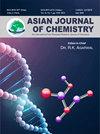新型 ZrO2/g-C3N4/CuFe2O4 纳米复合材料的合成及其对阿莫西林、毒死蜱和亚甲基蓝的高效光催化降解作用
Q4 Chemistry
引用次数: 0
摘要
采用湿法浸渍法合成了一种新型 ZrO2/g-C3N4/CuFe2O4 纳米复合材料,并研究了其在液体介质的暗光和可见光条件下对抗生素药物(阿莫西林)、农药(毒死蜱)和染料(亚甲基蓝)等有机污染物的光催化降解效果。利用 XRD、TEM、EDS、XPS、UV-Vis DRS、PL、BET 和 EIS 分析技术对合成的纳米复合材料及其光催化降解研究进行了表征。在三种有机污染物中,以 ZrO2/g-C3N4/CuFe2O4 纳米复合材料为光催化剂,在可见光照射 90 分钟的条件下,亚甲基蓝污染物的光催化降解率(99.5%,k = 0.0533 min-1)高于毒死蜱(97.3%,k = 0.0367 min-1)和阿莫西林(64.6%,k = 0.0109 min-1)。该纳米复合材料在可见光照射下表现出极佳的降解效率,而在黑暗条件下的降解则非常有限。作为对照实验,纳米复合材料中的 g-C3N4、ZrO2 和 CuFe2O4 单个组分在相同条件下的降解效率比 ZrO2/g-C3N4/CuFe2O4 纳米复合材料有限。此外,还提出了一种可能的光降解机制。由于这种新型纳米复合材料 ZrO2/g-C3N4/CuFe2O4 具有高稳定性和可重复使用性,因此可以实现废水的高效处理。本文章由计算机程序翻译,如有差异,请以英文原文为准。
Synthesis of Novel ZrO2/g-C3N4/CuFe2O4 Nanocomposite and Its Efficient Photocatalytic Degradation of Amoxicillin, Chlorpyrifos and Methylene Blue
A novel ZrO2/g-C3N4/CuFe2O4 nanocomposite was synthesized by wet impregnation method and its photocatalytic degradation efficacy is studied on the organic pollutants viz. antibiotic drug (amoxicillin), pesticide (chlorpyrifos) and dye (methylene blue) under both dark and visible light conditions in liquid medium. The synthesized nanocomposite and its photocatalytic degradation studies were well characterized using XRD, TEM, EDS, XPS, UV-Vis DRS, PL, BET and EIS analytical techniques. Among three organic pollutants, the photocatalytic degradation of methylene blue pollutant is higher (99.5%, k = 0.0533 min-1) than that of chlorpyrifos (97.3% k = 0.0367 min-1) and amoxicillin (64.6%, k = 0.0109 min-1) under visible light exposure for 90 min using ZrO2/g-C3N4/CuFe2O4 nanocomposite as a photocatalyst. The nanocomposite showed excellent degradation efficiency under the irradiation of visible light while the degradation under dark condition is highly limited. As a control experiment the individual g-C3N4, ZrO2 and CuFe2O4 components of the nanocomposite under the same conditions possess limited degradation efficiency than that of ZrO2/g-C3N4/CuFe2O4 nanocomposite. A possible photo-degradation mechanism is also proposed. Efficient treatment of wastewater could be possible with this novel nanocomposite ZrO2/g-C3N4/CuFe2O4 due to its high stability and reusability.
求助全文
通过发布文献求助,成功后即可免费获取论文全文。
去求助
来源期刊

Asian Journal of Chemistry
化学-化学综合
CiteScore
0.80
自引率
0.00%
发文量
229
审稿时长
4 months
期刊介绍:
Information not localized
 求助内容:
求助内容: 应助结果提醒方式:
应助结果提醒方式:


